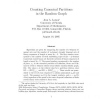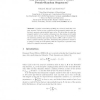68 search results - page 4 / 14 » Autocorrelations of Random Binary Sequences |
COMBINATORICA
2008
13 years 6 months ago
2008
Algorithms are given for computing the number of n-element diagonal sets and the number of n-element strongly diagonal sets of binary sequences of length at most 2n - 2. The first...
IJNSEC
2011
13 years 2 months ago
2011
In this paper, cyclic elliptic curves of the form y2 + xy = x3 + ax2 + b, a, b ∈ GF(2m ) with order M is considered in the design of a Symmetric Key Image Encryption Scheme with...
CORR
2008
Springer
13 years 7 months ago
2008
Springer
Abstract-- We consider code division multiple access communication over a binary input additive white Gaussian noise channel using random spreading. For a general class of symmetri...
MFCS
2000
Springer
13 years 11 months ago
2000
Springer
Abstract. A binary sequence A = A(0)A(1) . . . is called infinitely often (i.o.) Turing-autoreducible if A is reducible to itself via an oracle Turing machine that never queries it...
ICANN
2005
Springer
14 years 29 days ago
2005
Springer
Abstract. Dynamic neural filters (DNFs) are recurrent networks of binary neurons. Under proper conditions of their synaptic matrix they are known to generate exponentially large c...


